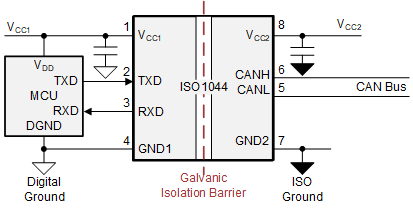SLLA486A May 2020 – May 2021 ISO1042 , ISO1042-Q1 , ISO1044 , ISO1050 , ISOW1044
- Trademarks
- 1 When Do I Need to Isolate CAN?
- 2 What are the Options Available to Isolate CAN Bus?
- 3 Now That I Have Isolated CAN Signal Path, How Do I Generate Isolated Power?
- 4 What’s the Reason Behind Terminating the Bus, Do I Need it, and How to Achieve it?
- 5 What’s the Difference Between Common Mode Range and Bus Standoff Mentioned in Data Sheet?
- 6 Now That I Have Taken Care of the Termination Resistor, What Other Components do I Need on the Bus Side?
- 7 When Connecting Isolated CAN Nodes in a Network, What Should be Done with the Floating Bus-Side Ground Connection?
- 8 Is There a Limitation on Minimum Data Rate That I Can Operate? What About the Maximum Data Rate Achievable in a Network?
- 9 Is There a Limit on Maximum Number of Nodes That I Can Connect in CAN Network?
- 10What Factors Decide the Maximum Communication Distance in a CAN Network?
- 11What is the Maximum Value of Bus Capacitance That Can be Introduced Between CANH to GND and CANL to GND? Can Higher Capacitance Damage the Device?
- 12Is There a Way to Extend the Maximum Communication Distance?
- 13What is Stub Length? What are the Design Considerations Around it?
- 14I am Seeing Larger Differential CAN Voltage for Some Bits of CAN Packet Compared to Rest of the Packet When I am Communicating in a Network with Multiple Nodes Connected. Why?
- 15References
- 16Revision History
2 What are the Options Available to Isolate CAN Bus?
Isolation of CAN bus is accomplished by placing an isolation barrier at digital logic interface between the MCU and CAN transceiver. System designers use either discrete or integrated solutions for isolating CAN bus. Discrete solution can be implemented using a digital Isolator such as ISO7721, and a CAN transceiver. The CAN standard places strict timing requirements on total loop delay and on pulse width distortion for FD data rates (2 Mbps and 5 Mbps). Discrete solutions will need to account for PCB parasitics that exist in the signal path which can impact timing, to ensure they are compliant to the CAN standard since timing is critical for bit-wise arbitration and signal integrity. Integrated isolated CAN devices such as ISO1042, ISO1044, and ISOW1044, other than providing board space savings, have these timing specifications guaranteed in the data sheet, eliminating extra simulations and tests needed for discrete solutions. Figure 2-1 shows this concept using ISO1044.
 Figure 2-1 Integrated Ultra-Small Package
Isolated CAN Device ISO1044
Figure 2-1 Integrated Ultra-Small Package
Isolated CAN Device ISO1044